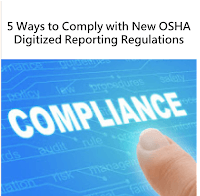原文刊載於:EHS Today(James Robins | Jul 13, 2018)
圖片來源:EHS Today
編輯翻譯:威煦軟體
學會如何取代手動、大量紙本的ESH工作流程,並達到OSHA合規標準。
2018年七月職業安全與健康管理局(OSHA)開始要求美國企業必須電子化申報工作場所的疾病與傷害報告。不幸的是,很多企業還尚未把他們的ESH數據轉換管理成電子化,這讓他們置身於高風險的罰款底下。以這些公司來說,以紙本文件或電子表格的的方式寄給OSHA的工作流程例如:安全會議、安全檢查、意外報告都還是常態。這是非常費時且容易出錯的流程,對於企業管理者與OSHA的意外與事件報告都造成延後。
企業無法忽視至少高達超過USD10,000的違規罰金,但是合規不光只是法令要求。遵守安全規則也創造出一個更安全、健康的工作場域文化,等同於創造出一個更具生產力、快樂的員工。
但是電子化的移轉可視為巨大的承諾。事實上,電子化移轉並不是一個一次性的作法。跳脫框架的數位化工具和流程可以幫助您完成符合OSHA新報告要求的艱苦工作,並使公司在數位化轉型上趨近成熟,以適合他們的速度發展,無需編碼。
如果您正在找尋一個脫離手動、大量紙本的ESH工作流程,並且符合OSHA的規定,同時實施良好的雇主安全措施,以下 5 點值得研究深思:
1. 先專注於彈性
ESH合規的項目清單上可以是極具變化、跨產業、甚至從設施到設施之間。因此,企業需要打造一個專屬他們自己需求的彈性清單。以雲端為基礎的 ESH apps提供跳脫框架、完全客製化的合規清單,它形成數位化,並可在任何智能設備使用。
Apps 幫你篩選規則,了解各規則適用於哪種情況。一個安全管理者只要輕鬆地輸入事件細節,apps會幫你做後續動作、交叉比對所有相關法規。這個直觀的做法移除了所有因為方程式所帶來的錯誤,並確保企業可以對自家內部數據以及OSHA報告都更有信心。
2.面向未來的合規性
在監管環境下,任何的風起變色都難以預測。為了確保現在與未來符合OSHA的規定,企業可以從數位化工作流程中獲益,從而簡化持續合規性。這是以雲端為基礎方法的優勢。隨著法規的變化,那些能夠通過中央控制台進行無代碼更新的apps,會自動把這些更改運作到所有設備,這讓安全管理者確信能在正確的時刻,獲得正確的資訊。
3. 培養一個從上而下圍繞在安全的工作場域文化
創造一個合規的文化很重要,而培養一個強調工作場域安全的文化亦同。以安全為中心的文化指的是如何在工作場所管理ESH-態度、價值觀、信仰,以及做事方式。這是管理者和員工共同致力於確保安全工作環境的承諾,也是防止傷害和事故的第一道防線。這樣想吧:OSHA是個法令,ESH是個文化。如果這個文化不到位,則任何數量的工具或技術修復都不太可能影響合規性或員工的健康和安全。
培養安全文化始於最高層。為此,執行管理層必須致力於提供資源,工具和培訓(OHSA提供許多計劃以幫助企業安全地開展工作),以及幫助員工安全工作所需的指導。如果將正確的基調和承諾放在首位,這種文化的可信度和動力將在整個組織中逐漸滲透。
4.用正確的技術實現文化
從上而下的領導是邁向培養工作場所安全文化的第一步,但這不全然是高階主管的責任。公司必須投資能夠實現這種文化的正確工具和技術。為什麼呢?傳統的紙本流程增加了追蹤和管理法規的複雜性,且隨著公司的發展而無法擴展。這些工作流程不光是一種負擔和責任,也阻礙了ESH文化的採用——當他們的時間可以更好地用於其他地方以幫助預防事故時,卻因為人員過度擴張,陷入手動,繁瑣的過程。
客製化解決方案曾經是答案,但缺乏公司擴展或適應不斷變化的監管環境的靈活性,需要昂貴的編程幫助。這會有什麼影響呢?該公司仍然受到僵化結構的約束,使其不合規,無法適應不斷變化的工作實踐。
現今的技術應用提供了先進的解決方案,可以幫助支持和維持EHS的卓越文化。數位 EHS apps 包括現成的軟體,可以滿足公司的各種需求、即時合規(無需構建自己的系統),同時具有足夠的靈活性,可以簡化,無縫且無影響的方式跟上變化的步伐。
5. 使用數據來通知公司決策和公司健康
改變公司處理環境安全和健康的方法關鍵之一,卻時常被我們給忽略,那就是從數據與它的脈絡中學習。
數位化的工作流程帶來的報告準確性和報告速度提高,有助於描繪出該領域正在發生事情一個更完整和更詳細的樣貌。使用即時數據而不是大量紙本時,公司可以提取,分析,共享和應用這些數據洞察,以防止未來問題出現並改善工作條件。在財務方面,這意味著在保險、工時損失的節省,還能避免OSHA的巨額罰款。
結論是,遵守OSHA的新數字報告是所有組織應該要接受,並使公司流程現代化的關鍵。除了降低風險之外,數位化EHS工作流程還帶來了許多優勢,可以推動公司轉型和現代化 ——提供更多公司可見性,釋放員工和資源,並帶來新的數據洞察力。
【原文對照】
5 Ways to Comply with New OSHA Digitized Reporting Regulations
This summer heralds in a new and challenging phase of environmental health and safety (EHS) regulation reporting. Starting in July 2018, the Occupational Safety and Health Administration (OSHA) will require businesses across the U.S. to submit workplace illness and injury reports digitally. Unfortunately, many businesses have yet to make the shift to managing their EHS data digitally, putting them at risk of significant fines. For these companies, workflows such as safety meetings, safety inspections and accident reports documented on paper forms or spreadsheets and mailed to OSHA are still the norm. It’s a time-consuming and error-prone process that also delays accident and incident reporting to both business managers and OSHA.
With non-compliance fines starting at over $10,000, it’s a problem that companies can’t afford to ignore. But compliance isn’t just a legal mandate; observing safety rules also creates a safer, healthier workplace culture for all—which equates to more productive and happier employees.
But digital transformation can seem like a huge undertaking. Truth is, it doesn’t have to be an all-in approach. Today, out-of-the-box digital tools and processes take the hard work out of meeting OSHA’s new reporting requirements and move companies up the digital transformation maturity ladder, at a pace that works for them, with no coding.
If you’re looking to move away from manual, paper-intensive EHS workflows and achieve OSHA compliance, while implementing good employer safety practices, following are five things to consider.
1. Focus on Flexibility First
EHS compliance checklists can vary across industry and even from facility-to-facility. As such, businesses need the flexibility to create checklists specific to their needs. Cloud-based EHS apps provide out-of-the-box, fully-customizable compliance checklists and forms digitized for use on any smart device.
Instead of sifting through regulations to understand which applies in each case, these apps do the thinking for you. A safety manager simply fills in the details of the incident and the app does the rest, crosschecking all the relevant regulations. This intuitive approach removes any error from the equation and ensures the business has more confidence in its data for internal purposes and OSHA reporting.
2. Future-Proof Your Compliance
In the regulatory environment, the winds of change are never not in the forecast. To ensure compliance with current and future OSHA regulations, businesses can benefit from a digitized workflow that simplifies ongoing compliance. That’s the advantage of a cloud-based approach. As regulations change, apps that allow for no-code updates through a central console then roll those changes out to all devices automatically, which helps give safety managers the confidence that they are collecting the right information, at the right juncture.
3. Cultivate a Workplace Culture around Safety—from the Top, Down
Creating a culture of compliance is important, but equally so is cultivating a culture that emphasizes workplace safety. A safety-centric culture refers to how EHS is managed in the workplace—the attitudes, values, beliefs and ways of doing things. It’s a shared commitment across managers and employees towards ensuring a safe work environment and is the first line of defense against injury and accidents. Think of it this way: While OSHA is the sanction, EHS is the culture. If that culture is not in place, then any number of tools or technology fixes aren’t likely to move the needle on compliance or employee health and safety.
Fostering a culture of safety starts at the top. To this end, executive management must commit to providing the resources, tools, training (OHSA offers a number of programs to help businesses do their work safely), and guidance needed to help employees work safely. With the right tone and commitment set at the top, credibility and momentum for such a culture will trickle down throughout the organization.
4. Enable that Culture with the Right Technology
Top-down leadership is the first step towards cultivating a workplace safety culture, but the onus doesn’t have to be all on the C-suite. Companies must invest in the right tools and technology that enable that culture. Why?
Legacy paper-based processes add complexity to the tracking and management of regulations and fail to scale as companies grow. Not only are these workflows a burden and a liability, their very unwieldiness stymies the adoption of an EHS culture—staff are over-extended, bogged down in manual, tedious processes when their time could be better utilized elsewhere to help prevent incidents.
Bespoke solutions used to be the answer but lack the flexibility to scale with the business or adopt to the changing regulatory environment, without the need for costly programming help. The impact? The business remains bound by a rigid structure, opening it up to non-compliance and an inability to adapt to changing working practices.
Today’s technology applications offer advanced solutions that can help support and sustain a culture of EHS excellence. Digital EHS apps include ready-baked software that enables instant compliance (no need to build your own system) across the various needs of the business, while being flexible enough to keep pace with change in a streamlined, seamless and non-impactful way.
5. Use Data to Inform Business Decisions and Health of Your Business
A critical yet often overlooked best practice for changing the way your business approaches environmental health and safety is learning from the data at its fingertips. Improvements in accuracy and speed of reporting brought about by digitized workflows help paint a more complete and detailed picture of what is happening in the field. Using real-time data rather than sifting through mounds of paper, companies can extract, analyze, share and apply those data insights to prevent future problems and improve working conditions. On the financial front, that represents a potentially huge savings in terms of insurance, lost man-hours, and of course avoiding giant fines from OSHA.
In conclusion, compliance with OSHA’s new digital reporting regulations is an impetus that all organizations should embrace to modernize key business processes. In addition to risk-mitigation, digitizing your EHS workflow brings a multitude of benefits that can drive business transformation and modernization—providing more visibility across the business, freeing up employees and resources, and bringing new data insights.
獨家文章轉載請註明來源:威煦軟體
本篇文章內容僅供參考,文章及圖片來源:EHSToday
延伸閱讀
ISO 45001:2018 (原OHSAS 18001)職業安全衛生管理系統
– ESH SOFTWARE DEVELOPER –
職安救星|環安雲|環安衛管理系統專門開發及銷售
威煦軟體開發有限公司 |E-MAIL: INFO@WISHINGSOFT.COM | TEL: 070-1018-0999






